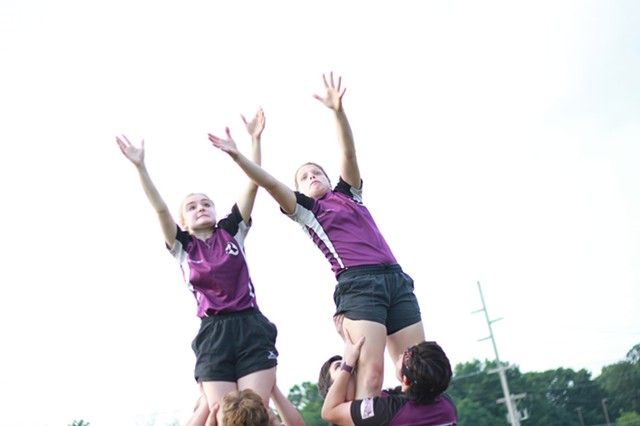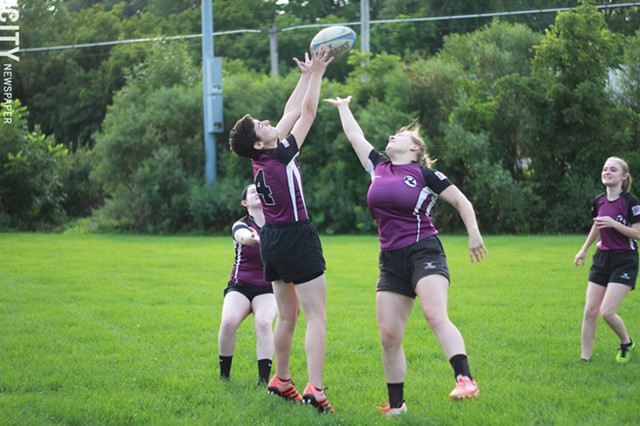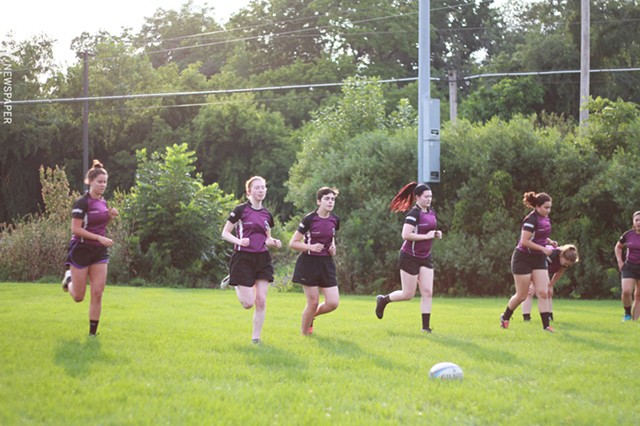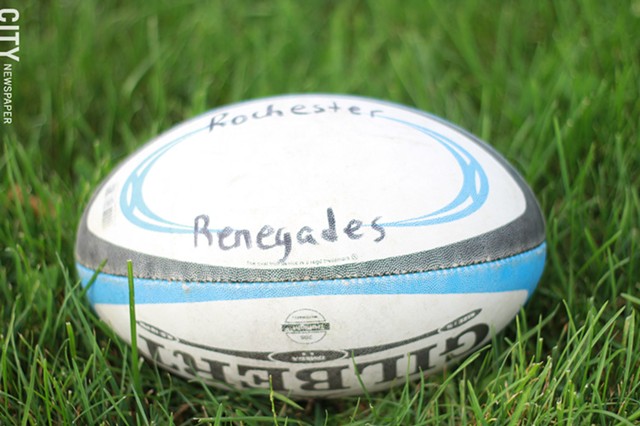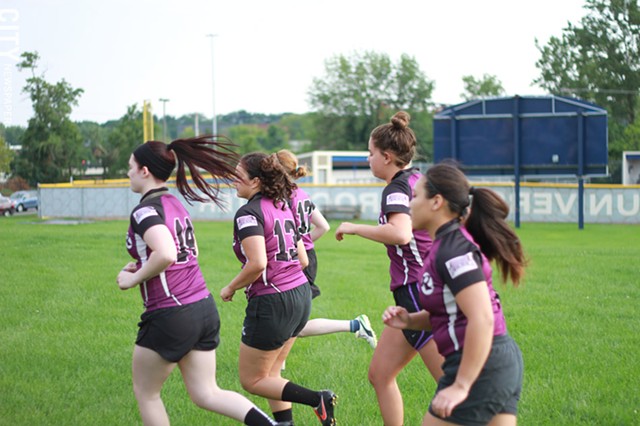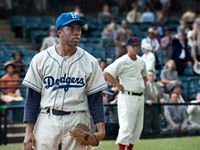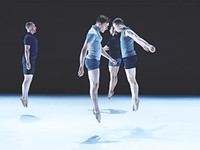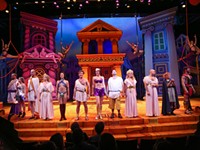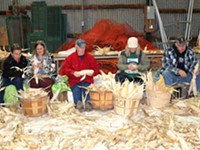[
{
"name": "500x250 Ad",
"insertPoint": "5",
"component": "15667920",
"parentWrapperClass": "",
"requiredCountToDisplay": "1"
}
]
"Ball! Ball! Ball!" a woman shouts through her mouthguard. Her teammate hurls the large oval-shaped ball toward her, she catches it, cradles it in her arms, and then darts left, then quickly right to try and evade the other woman running at her.
"Raaaarrrrggh!" the opponent yells as she hurtles toward the ball carrier.
"Go 'Bambi.' You got her!" the team's captain, "B," shouts from nearby.
"Bambi," a fairly slender but athletic woman, lunges at the ball carrier's waist, wrapping her arms around her and pushing her backwards. The carrier falters slightly, but pushes back for a moment before finally slamming to the ground.
"Good tackle, 'Bambi,'" her teammates laud.
"Bambi" picks herself up and then offers a hand to her teammate. It's a true showing that even during practice, the Rochester Renegades women's rugby team follows the spirit of the game: rugby is a hooligan's sport played by gentlemen and ladies.
The Renegades is one of three rugby clubs in the Rochester area, and has been around for 30 years. The team plays in the Empire GU Rugby Union — an organization that oversees more than 100 clubs in New York, northern New Jersey, and southwest Connecticut — and has around 20 to 35 players, ranging in age from about 20 to mid-30's. And each player has their own, unique nickname.
"No one really goes by their real names," says Meredith Pyke, aka "B," the Renegades' co-captain. She got her nickname because she wears a bandana to every match.
"Trying to find someone on Facebook that I met through the rugby community is impossible," Kayleigh "Rage" Roderick says, chiming in.
There are also two men's teams in town: the Aardvarks and the Colonials. The largest and oldest (founded in 1966) of the three local teams, the Aardvarks has about 60 active players, making up two teams in the Empire GU Rugby Union — one in Division II and one in Division III. It's also the only club with its own stadium, Aardvark Park on East Henrietta Road.
The Colonials RFC was founded in 1980 and has around 30 to 40 members. It plays against Division III teams in the Empire GU Rugby Union (including against the Aardvarks).
Locally, the Aardvarks', Colonials', and Renegades' seasons run from late August and early September through November, and if teams perform well enough in the fall, they'll make it into the playoffs during the spring. If not, the teams play in tournaments or friendly matches — something that continues into the summer to help them stay on top of their game.
Steven Zarajczyk has been playing with the Aardvarks for several years. "I moved here and didn't know anyone," Zarajczyk says. "But when I joined the Aardvarks, it was like, 'Boom!' Instant friends."
Zarajczyk got into rugby in college after seeing his brother play; he had previously played soccer and was a wrestler, so rugby seemed like a good fit.
On the surface, rugby appears to be a rougher version of football, sans helmets and pads. "A lot of people think it's just guys who couldn't make it on the football team," Zarajczyk says. While there are some similarities, "it's definitely more strategic and complicated than that."
Rugby matches are played in two, 40-minute halves, with two teams of 15 players each. Each team is split into two groups: the Pack and the Back (check out our short list of positions and rugby jargon on page XX). The Pack refers to the front three rows of players, whose goal is to gain and retain possession of the ball. Those players are typically larger and participate in scrums, rucks, and mauls. The Back refers to a group of seven players whose mission is to create and convert scoring opportunities — these players can be smaller and are usually faster and more agile to avoid tackles.
While players have set positions, things can change quickly in this fast-paced sport. "You gotta be ready for anything," Zarajczyk says. "If I get up from a tackle, and I'm in a good scoring position, I gotta be ready to get that ball and run it. It's all on the fly."
The ball is moved forward in one of three ways: kicking, a player running with the ball, or within a scrum or maul. If they have space, players can punt the ball to clear it out or gain ground. Players can only pass the ball laterally or backwards — forward-passing isn't allowed — and they can run in any direction they want, but they can't use teammates to obstruct the opposition from getting to them.
When the ball carrier is tackled to the ground, they must immediately release the ball or pass it to a teammate. Generally, tackles are made at waist-level or lower by wrapping the arms around the opponent and forcing them to the ground. Players aren't allowed to pick up their opponent during a tackle, and must also remain on their feet. If they lose their footing and their knees touch the ground, the tackle is invalid.
"With tackling, there's definitely a method to the madness," Roderick says, emphasizing that the tackling technique and strict rules surrounding it help prevent injuries. "Because we have to be more aware of what we're doing with our bodies, it's arguably safer than a football tackle."
Tackling can sometimes lead to a maul, which happens when the player carrying the ball is held by one or more of their opponents and the ball carrier's teammates bind on for support. If the maul stops moving forward for too long, the ref (called a "Sir") awards a scrum to the opposing team.
A scrum is a way of resetting and is formed when the eight players in the Pack bind together shoulder to shoulder and face off head to head against the opposing team. The ball is thrown in between them (in what's called "the tunnel") and players must use their feet to knock the ball back into their team's territory.
If the ball pops loose after a tackle, sometimes a ruck can form when at least one player from each side bind onto each other with the ball on the ground between them. Other players may join in, but must do so behind the rearmost player on their side. Without using their hands, the players are trying to get the ball back into their team's territory.
The overall goal of all the running, passing, tackling and rucking is to get the ball into the Try Zone (like an end zone in football) to score a try, which is worth five points. Unlike football, running into the zone isn't enough — you must place the ball on the ground. "It has to be a deliberate, downward motion," Zarajczyk says. "You have to have possession. You can't just drop or fumble it in."
The conversion kick that follows is worth two points, and is taken 22 meters out from the point in the Try Zone where the ball was grounded. "So if you score on the edge of the Try Zone near the sidelines, your kicker has to try and kick it at an angle," Zarajczyk says. To score, the ball must go through the H-shaped goal posts to count.
Points can also be scored on a drop kick — kicking the ball from the field through the uprights during game play — or on a penalty kick, which is awarded for rough or illegal play.
"It's a complicated game," Roderick says. "But somehow it all comes together as a beautiful disaster."
"I always know I played a game because my arms hurt the next day," Pyke says. I can attest. After practicing with the Renegades for about an hour and a half, every muscle in my body was sore. Walking up and down stairs or twisting my torso around was painful.
"But it's the good kind of sore. It makes you feel strong, powerful even," Pyke adds.
The only real difference between men's and women's rugby is that women are allowed thin padding for their torsos — although none of the Renegades I talked to actually use it. "Especially in women's rugby, it's a lot less about brute force and more about finesse and strategy," Pyke says.
Players in both men's and women's rugby are allowed to wear mouth guards, shin guards, and a thin rubber cap to protect their ears.
"It looks a little chaotic, but I feel safe," Zarajczyk says. "You'll end up bruised, but there aren't really any more injuries in rugby than in any other sport."
All three Rochester teams do not require try-outs to join. One of the biggest misconceptions about rugby, Pyke says, is that only people of a certain body type can play. "It's just absolutely false," she says. "We really have a spot for everybody."
Her co-captain, Maeve "Marv" Kean, agrees. "Every body type is valuable," she says. "Big, small, short, tall, fast. We need everyone. And as your body changes, you can adapt what position you play to suit that."
Rugby is something Roderick sees as particularly good for women. "There's something really satisfying about playing rugby and knowing you're playing the exact same game as the guys," she says. "It makes you feel strong — no matter who you are, no matter what size you are, it's hard to walk out of a game and not have a moment where you felt strong or powerful, and that's valuable to feel that way."
Another valuable aspect, players say, is the comradery among the teams. "In the rugby community, there's such a level of mutual respect," Roderick says. "You want to see each other get better because it forces your team to get better. When you go to a tournament, you destroy each other on the field, but then after, everyone's just friends."
And that's something all three local teams are focused on: keeping that comradery going and building up excitement for the sport, either through new players or fans. All three teams are self-funded through team dues, sponsorships and fundraisers, and the games and practices are open to all (although if you want to watch, bring a chair or blanket to sit on).
"It's one of two ways; there's no one in the middle," Pyke says. "You either don't like it or fall in love with the rugby culture and dive head first into it — literally."
Rugby in Rochester
Rochester Aardvarks
Practices Tuesday and Thursdays; games on Saturdays in the fall
Aardvark Park, 3625 East Henrietta Road
486-1831; aardvarkrfc.com
Rochester Colonials
Practices Tuesdays, Thursdays, and Saturdays; games on Saturdays in the fall at Aardvark Park
Rochester Renegades
Practices Tuesdays and Thursdays; games on Saturdays in the fall, sometimes in the spring
Rugby Terms
Back: Refers to group of seven players whose goal is to create and convert scoring opportunities. Generally smaller than the "Pack" and also faster and more agile to dodge tackles.
Conversion Kick: Taken after a successful try. It is worth two points when the ball is kicked through the H-shaped goal posts. The ball is placed 22 meters out from wherever the try was scored.
Drop Goal: Happens when player kicks the ball through the H-shaped goal posts. It is allowed to hit the crossbar and still count. Worth three points.
High-Tackle: Happens when the player tackles an opponent at their shoulder-level or above. An illegal move that will result in a penalty and/or the offending player being removed from the game.
Line Out: When the ball goes out of bounds. It is re-introduced to the field like a throw-in in soccer.
Maul: Happens when the player carrying the ball is held by one or more of their opponents and the ball carrier's teammates bind to him or her for support.
Off-Sides: The invisible line created by where the ball is during open play. When the ball is carried by a single player in open play, any other player on the same team who is in front of the ball carrier is in an offside position. When the ball is in a ruck, maul, or line-out, any player who is in front of the rear-most player of the same side is off-sides. When the ball is in a scrum, the scrum-half must remain behind the ball and all other players not in the scrum must remain behind a line parallel to the goal-line and five meters behind the rear-most players' foot.
Pack: Refers to front three rows of players, whose goal is to gain and retain possession of the ball. Generally players are of a larger build and participate in scrums and line-outs.
Penalty Kick: Awarded after penalties or dangerous play occurs.
Place Kick: When the ball is placed on the ground, generally in a kicking stand or tee, while a team is converting on a try or after a penalty has been awarded.
Ruck: Happens when at least one player from each side bind onto each other with the ball on the ground between them. Other players may join the ruck, but must do so behind the rearmost player on their side. In a ruck, players may not use their hands to get the ball, and instead, players use their feet to hook the ball into their team's territory. Any players not in the ruck must stay behind the off-sides line.
Rugby Sevens: A modified version of rugby, often played in tournaments, that follows similar rules, except halves are only 7 minutes long and there are only 7 players per side.
Sir: The respectful name for the referee. Only one player (the captain) is allowed to talk with the Sir during the game. Term is applied to both male and female referees.
Scrum: A way of restarting the game after a minor infringement, or when the ball is trapped in a ruck or a maul and has no realistic possibility of being played. A scrum is formed when the eight forwards bind together and face off literally head-to-head (well technically more like shoulder to shoulder against the opposing team.) The ball is thrown in between them (in what's called the "tunnel") and players must then use their feet to knock the ball backwards into their team's territory.
Tunnel: Refers to the space between opposing teams in a Scrum.
Try: A way of scoring points. Happens when a player enters the Try Zone and deliberately puts the ball on the ground. Worth five points.
Try Zone: The space at either end of the field in which teams can score. Includes an H-shaped goal post used for conversion kicks and drop goals.
In This Guide...
Speaking of...
-

Rochester’s steel-tip darts community keeps throwing
Jun 27, 2018 -

Best Local Color 2017
Oct 25, 2017 -

Pulling back the curtain
Sep 13, 2017 - More »
